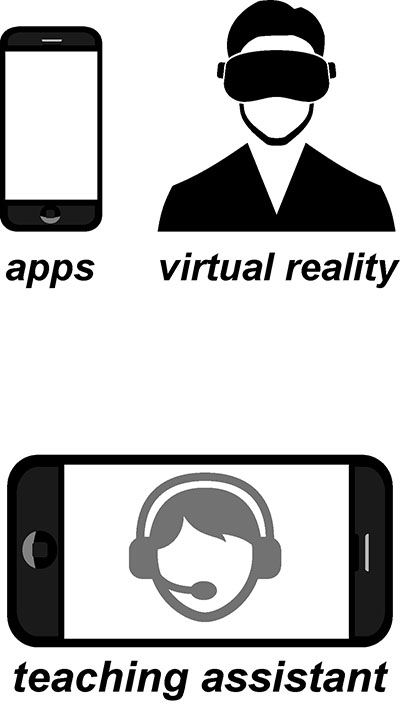 Traditional coursework often relies on large quantities of data and complex equations, making it challenging for students to grasp concepts tactically. Augmented reality (AR) and artificial intelligence (AI) can revolutionize education by transforming these datasets and equations into physiologically accurate simulations of real processes, providing students with an intuitive understanding of scientific theories and clinical datasets. For example, within simulated clinical scenarios, a student could use a mobile device to visualize a drug’s distribution through patient’s bodyin real time (figure to the right). These innovative tools help bridge the conceptual gap that makes traditional coursework difficult, offering a more immersive and intuitive learning experience. In the long term, AR and AI could serve as medical assistants, enabling clinicians to navigate complex data analysis effortlessly without having to perform intricate mathematical calculations themselves. This integration not only enhances learning but also equips future professionals with the skills to handle advanced medical technologies effectively.
Traditional coursework often relies on large quantities of data and complex equations, making it challenging for students to grasp concepts tactically. Augmented reality (AR) and artificial intelligence (AI) can revolutionize education by transforming these datasets and equations into physiologically accurate simulations of real processes, providing students with an intuitive understanding of scientific theories and clinical datasets. For example, within simulated clinical scenarios, a student could use a mobile device to visualize a drug’s distribution through patient’s bodyin real time (figure to the right). These innovative tools help bridge the conceptual gap that makes traditional coursework difficult, offering a more immersive and intuitive learning experience. In the long term, AR and AI could serve as medical assistants, enabling clinicians to navigate complex data analysis effortlessly without having to perform intricate mathematical calculations themselves. This integration not only enhances learning but also equips future professionals with the skills to handle advanced medical technologies effectively.
Clinical knowledge to digital tools workflow

A major goal of SMDA’s VR/AI Education working group is to unlock the datasets underlying traditional healthcare curricula to enable accurate simulation of clinical scenarios and patient physiology. As illustrated in the figure to the right, patient-specific datasets can be curated from clinical literature to enable quantitative simulations of patient cases, patient diagnostics, and clinical scenarios. Additionally, the raw text from this clinical literature can be used to build automated teaching assistants that have “read” the entire body of clinical literature relevant to a particular course or topic. In the long term, we envision these teaching assistants serving as medical assistants, helping practicing clinicians navigate the millions of scientific and clinical papers available in areas like cancer and infectious disease research. This integration of VR and AI into healthcare education aims to enhance both learning and practical application in clinical settings.
Tactical Priorities
|
 |
Strategic Priorities
… |
 |
Current Members
- Russ Palmer
- Katie Smith
- Matthew Schmidt
- Richard Lamb
- James Moore
- Eugene Douglass
- Joshua Caballero
Software Tools
- Patient Generators:
- Case Generators:
- Lecture Assistant Apps:
- Class Room Management Apps:
…
Cleaned Datasets
- Normal Patient Physiology Ranges
- Case Reports Datasets
- 2D Graphics for Lecture Design
- 3D models for Lecture Design
- Animations for Lecture Design
…
…
Key Performance Indicators: summary statistics
| KPI Category | KPI | Current Value |
|---|---|---|
| Research and Publications | Number of Published Papers | |
| Impact Factor of Journals | ||
| Citations | ||
| Conference Presentations | ||
| Collaboration and Engagement | Interdisciplinary Projects | |
| External Collaborations | ||
| Collaborative Publications | % | |
| Workshops and Seminars | ||
| Funding and Grants | Research Grants Received | $ |
| Grant Applications Submitted | ||
| Grant Success Rate | % | |
| Data and Tools | Datasets Published | |
| Software Tools Developed | ||
| Tool Adoption | downloads | |
| Training and Development | Students Supervised | |
| Training Programs | ||
| Skill Development | certificates | |
| Impact and Outreach | Societal Impact | |
| Media Mentions | ||
| Public Engagement | events | |
| Operational Efficiency | Project Completion Rate | |
| Data Management Practices | % compliance | |
| Resource Utilization | % efficiency | |
| Innovation and Excellence | Awards and Recognitions | |
| Innovative Solutions | breakthroughs | |
| Feedback and Improvement | Stakeholder Feedback | satisfaction |
| Continuous Improvement | # iterations |
Key Performance Indicators: specific items list
Protected Content
- Research and Publications
- Number of Published Papers
- Impact Factor of Journals
- Citations
- Conference Presentations
- Collaboration and Engagement
- Interdisciplinary Projects
- External Collaborations
- Collaborative Publications
- Workshops and Seminars
- Funding and Grants
- Research Grants Received
- Grant Applications Submitted
- Grant Success Rate
- Data and Tools
- Datasets Published
- Software Tools Developed
- Tool Adoption
- Training and Development
- Students Supervised
- Training Programs
- Skill Development
- Impact and Outreach
- Societal Impact
- Media Mentions
- Public Engagement
- Operational Efficiency
- Project Completion Rate
- Data Management Practices
- Resource Utilization
- Innovation and Excellence
- Awards and Recognitions
- Innovative Solutions
- Feedback and Improvement
- Stakeholder Feedback
- Continuous Improvement
…
…
…
…
